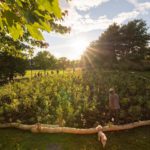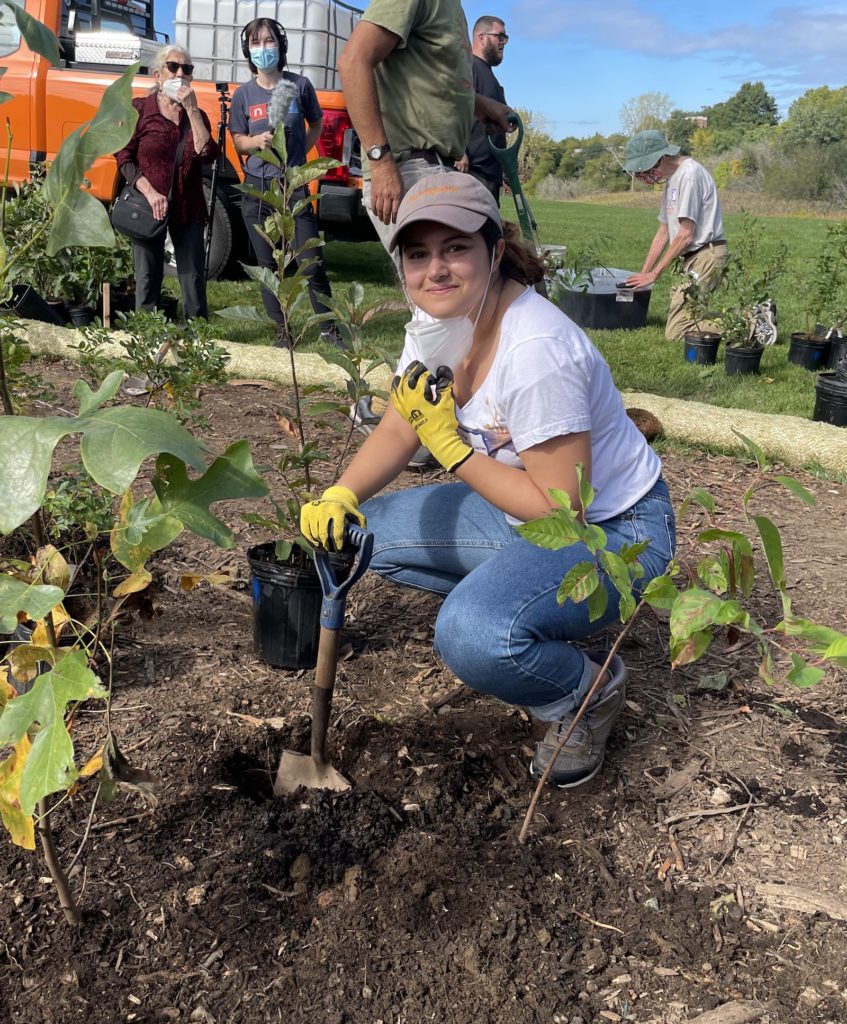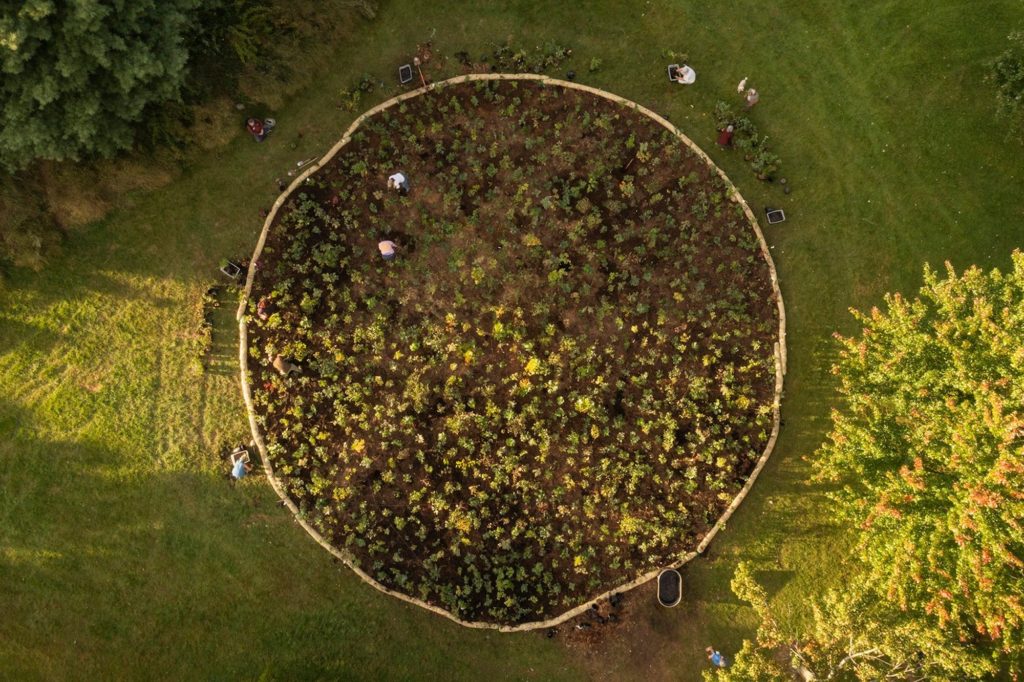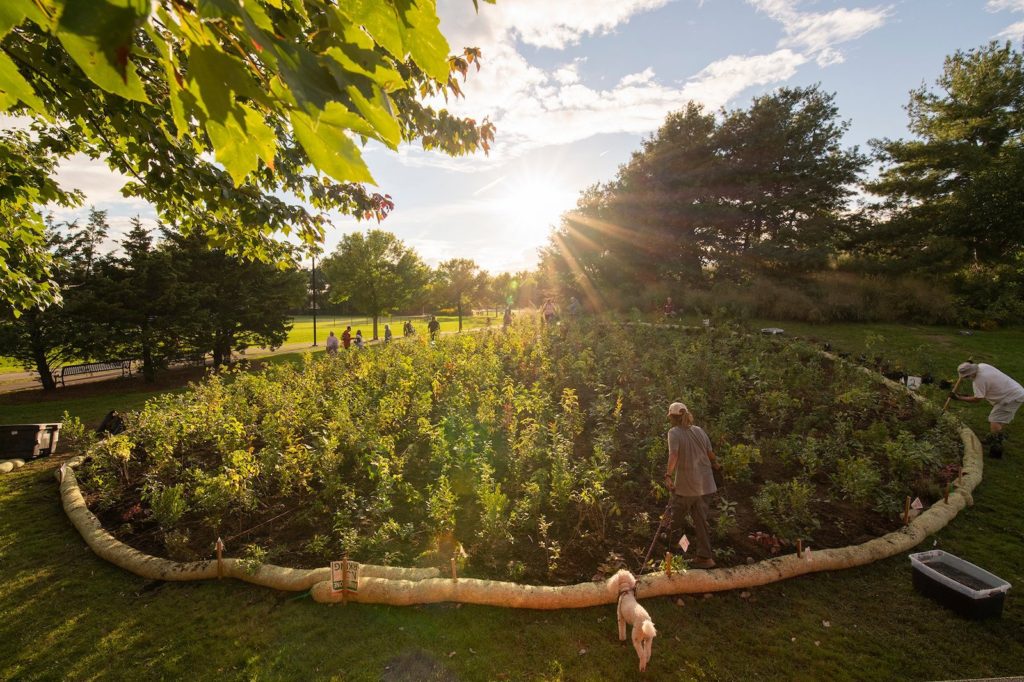
By Maya Dutta
The first Miyawaki forest in the northeast United States was planted in Cambridge’s Danehy Park last September. Miyawaki forests are dense, biodiverse pocket forests that aim to recreate the symbiotic relationships between diverse life forms that make a natural forest so resilient. By densely planting a diverse array of native species, Miyawaki forests encourage nutrient exchange between the plants and with fungal and microbial life in the soil, resulting in fast-growing forests with high survival rates.
Benefits of Miyawaki forests
The Miyawaki method offers a vision of not just planting trees to raise their sheer number, but to create full ecosystems in which different species work together to create more than the sum of their parts. The density, biodiversity, and focus on native species gives these pocket forests great impact.
Where one tree standing alone might be vulnerable to drought, storms, disease, or other extreme events, ecosystems prove resilient. Trees in forests take part in vast networks of roots and mycorrhizal fungi. They actually communicate with one another, sharing nutrients and water and even giving off signals of distress when threatened. Like most living creatures, these organisms are better and stronger together.
Miyawaki forests create ecosystems that are self-sustaining just a few years after planting. Benefits include increased biodiversity, support for pollinators and other insects and animals, carbon sequestration, air pollution filtering, greater soil water absorption, buffers against flooding and erosion, and cooling of the surrounding areas.
By creating pockets of biodiversity in our cities through Miyawaki forests and pollinator gardens, we can reap benefits from working with the living things around us. Because of their ability to alleviate excess heat and pollution, Miyawaki forests can help us build resilience where we are most vulnerable in our cities, combating environmental injustice. They can be deployed along with structures like rain gardens, helping absorb excess water to lessen flooding and erosion. They can become part of our natural infrastructure, an important method in our toolbox as we look for creative solutions for our climate challenges.
Miyawaki forests can also work as tools of education and connection, helping people learn about and participate consciously in their local ecology. Studies have shown the numerous benefits of green spaces in urban settings, including improving physical and mental health, recovery rates for hospital patients, behavior and learning in young children, and community members’ sense of well-being.
Many of us took refuge in nature as the Covid-19 pandemic forced us into lockdown, finding ourselves seeking solace in daily walks outside or involvement in gardening, hiking, or bird-watching. Ecologist E. O. Wilson coined the term “biophilia” for the innate human instinct to connect with nature and other living beings, and it is this principle that suggests how pocket forests and other havens of biodiversity can benefit us not just ecologically, but also spiritually and socially.
Building a forest
For this forest, Bio4Climate worked in partnership with SUGi, a Swiss-based organization, and a forest maker in their network, Ethan Bryson (of Natural Urban Forests), who directed our implementation of the Miyawaki method. We worked extensively with Andrew Putnam, the superintendent of urban forestry with the city of Cambridge and his colleagues in the city’s Department of Public Works. Our journey began with Ethan’s guidance on the Miyawaki method and its steps—site selection, soil survey, species selection, soil preparation, dense planting, and forest maintenance, which result in a forest that is self-sustaining after the first three years.
Andrew and his team helped narrow our site list and select a location, source plants from local nurseries, and acquire compost and biochar to prepare the soil before planting. More than 100 volunteers came out to plant the forest, and more will help steward the forest in its initial few years, periodically removing weeds that try to encroach the area, while watering is done via an automated irrigation system in the park.
Our wonderful teams of volunteers planted a multitude of species, creating what will develop into four vertical layers of forest: shrub, tree, mid-canopy and canopy levels. From the first central plantings of the sisters chokecherry and elderberry, we added maple, dogwood, sumac, white pine, hazelnut, witch hazel, rose, and others. They will flower and bloom at different times, change color and drop leaves, huddle underground under a blanket of winter snow.
Collaboration and deep connection are two elements that make Miyawaki forests so strong, essential to the way we can go on to both survive and even thrive in a world that is still being degraded. The forest is a testament to the vision and practice of restoration, making tangible so much of what I have learned in lectures, classes, conferences and my work with Bio4Climate. Ecological restoration is practical, and it is a joyful and fulfilling process that can bring communities closer together.
In planting these trees and shrubs, we created a community of life that will last much longer than any of us individually. We reinstated natural ecology on top of a city landfill, and witnessed firsthand the way eco-restoration can heal, not just biologically and chemically, but spiritually and communally.
From its inception to its ongoing growth and emerging place within its park and community, the Danehy Park Miyawaki forest project has been the product of many people’s efforts. By taking part, all of us have assumed a new role in this ecosystem, to act as stewards and enlarge the space for biodiversity. Our cities are a part of nature, and they can be places where nature is integrated rather than disrupted. In Cambridge, engaged citizens and a forward-looking city government are intent on building climate resilience through urban forestry.
Miyawaki forests suit urban Boston
Miyawaki forests can be created in areas as small as 1,000 square feet, about the size of six parking spaces. That size makes them particularly well suited to urban areas like Boston, where space is limited and while we have plenty of heat, pollution, storms, and flooding to worry about. Imagine how many yards, parks, school campuses, town squares, or even corners of parking lots have that much space to spare. Embracing the Miyawaki method could help us grow our resilience pocket by pocket across the greater Boston area, from Cambridge to Quincy, Somerville to Dorchester, Belmont to Eastie.
It has been moving to see the enthusiasm for this project from individuals and organizations in the Boston area and beyond. In addition to stewarding the Danehy Park Miyawaki forest in the coming years, we are imagining what comes next for the city of Cambridge, surrounding communities in metro-Boston, and cities and towns across the country and world. This forest, the first in the entire northeast United States, will certainly not be the last.
As we plant in our own communities, we also connect to a global movement of rewilding, and we can exchange lessons with many others who have worked on Miyawaki forest projects from Japan, India, South Africa, the UK, the Netherlands, and beyond.
To find out more about the Danehy Park Miyawaki forest, see photos and related resources, and get involved, check out Biodiversity for a Livable Climate’s Miyawaki Forest page.
Maya Dutta is the assistant director of regenerative projects at Biodiversity for a Livable Climate. She served as project manager for this Miyawaki Forest.





Sorry, the comment form is closed at this time.